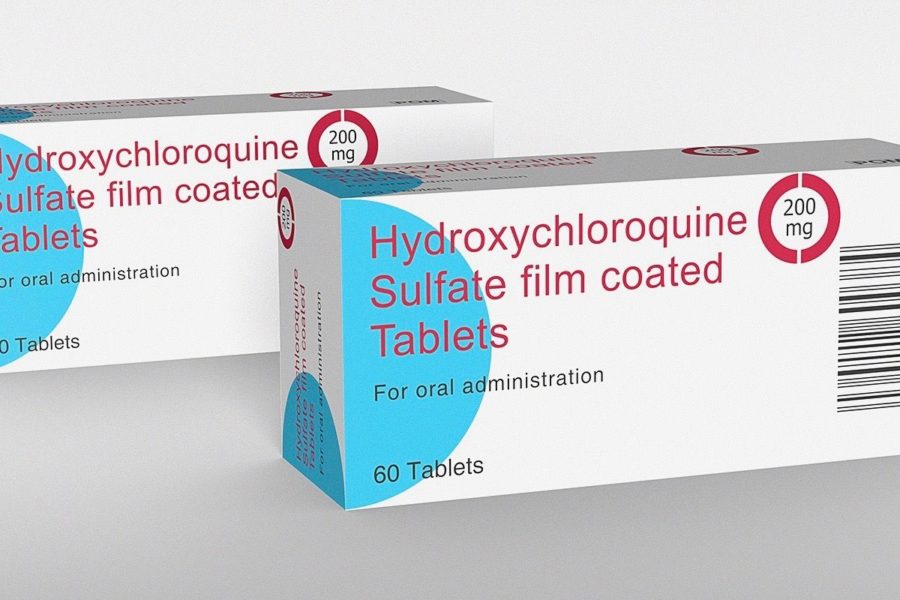Set forth below is my article that was published in yesterday’s The American Spectator about the antimalarial drug chloroquine being used alone or in combination with the antibiotic azithromycin to successfully treat and possibly prevent COVID-19 infections. When President Trump recently expressed his belief that chloroquine could be a “game changer” in the fight against the pandemic, the New York Times accused him of exaggerating its potential and claimed that it showed “limited evidence of healing the sick.” As you will see, the available evidence fully justifies Trump’s optimism.
Since publication, even more information has come to light supporting Trump’s view. For example, early yesterday morning, Novant Health, which owns and operates hospitals and clinics throughout North and South Carolina, published its “Inpatient Treatment Protocol for Lab-confirmed COVID-19”. This so-called “algorithm” provides for the use of hydroxychloroquine and azithromycin to treat COVID-19 infections in the same manner as described in the clinical studies and treatment protocols cited in my AmSpec article. Also, readers have kindly forwarded to me reports of additional clinical studies that also support the use of chloroquine alone or in combination with azithromycin.
And yesterday, Novartis, the pharmaceutical giant, committed to donate up to 130 million doses of hydroxychloroquine to support the COVID-19 response. This followed Bayer’s announcement that it is donating 3 million tablets of chloroquine phosphate for the treatment of COVID-19 patients.
These donations will be welcomed by the physicians in the New York metropolitan area and the West Coast who are successfully treating COVID-19 patients with chloroquine and warning that the supplies of the drug are dwindling.
All of this is good news and, after watching Trump’s pandemic briefing last evening, I get the impression that the Big Lockdown is about to be lifted. The President said that changes were going to be made sooner than later and that the nation can do two things at the same time, i.e., fight the pandemic and open its doors for business. With an able assist from Dr. Debra Birx, the smart, pleasant, shawl-wearing infectious disease expert, Trump explained to the skeptical reporters – who seemed to think that he is about to sell out the nation’s health for the benefit of big business – “we have learned a lot” about the true nature of the pandemic.
Trump pointed out that when the social distancing program was put in place, the experts’ best estimates placed the COVID-19 fatality rate at a catastrophic 5 %. Since then, with the advent of widespread testing and analysis of data gathered over the last eight days, it appears that the fatality rate is probably below 1 % which, if correct, means that COVID-19 is no more lethal than the seasonal influenza A that so far this year is estimated to have killed approximately 50,000 people. For those of us who have been warning that COVID-19’s estimated fatality rate was far too high (see my post “Apocalypse No”), Trump’s remarks came as a relief. Maybe, just maybe, sanity is about to rear its head in the midst of the COVID-19 panic.
Trump pointed out that, while there are areas such as New York, California and Washington state where the infection rate is high, most of the rest of the country is in much better shape. Dr. Birx offered that there could be local quarantines in the highly infected areas. She also noted that the average age of those in Italy who have died is 80 (!) and that many had co-morbidities such as heart disease and diabetes. There was a hint that, if commerce resumes, those at greatest risk, such as people over 65 years of age and with co-morbidities, may still be urged to self isolate.
But Trump repeated many times – as he is inclined to do – that we couldn’t afford to keep the economy shut down. In effect, he said in his tough-to-decipher syntax that the COVID-19 cure is approaching the point where it could be worse than the disease. He reiterated that we need to save big and small businesses so that people will have jobs and the economy can recover.
Sensing a line of attack, the reporters repeatedly asked if Dr. Fauci and the other medical advisers agreed with Trump’s sentiments. Trump and Dr. Birx answered only that data are still being gathered and a decision about continuing the self quarantine will be made “soon”.
If Trump lifts the lock down, I predict that the news media will attack him for risking a catastrophe just as they have meretriciously attacked him for purportedly not acting soon enough to protect the nation. NBC, ABC, CBS, CNN, and MSNBC will hang every subsequent fatality around his neck with nightly video obituaries of individuals struck down by COVID-19 all because Trump ended the fight against the pandemic too soon.
Well, enough of that. Here’s the article. Hope you find it to be of interest.
The Game Changer: President Trump Was Right | The American Spectator
At Thursday’s White House press briefing, President Trump and FDA Commissioner Stephen Hahn announced that the FDA has approved the “compassionate use” of the antimalarial drug chloroquine to treat patients infected with Coronavirus 2019 (“COVID-19”). Under extreme or exigent circumstances, the FDA may permit physicians to medicate patients with experimental drugs. The term “compassionate use” ordinarily refers to dosing a patient with a drug that has not been approved by the FDA for any purpose.
Since the 1940s, however, chloroquine has been FDA-approved and safely used to treat and prevent malaria. It has also been used to treat HIV and autoimmune disease. Its side effects are well known and, generally speaking, nonexistent to mild. As such, chloroquine is not an experimental drug requiring FDA permission before it can be prescribed. Instead, even though the FDA has not given blanket approval for its use in COVID-19 cases, physicians have been and are free to prescribe it for “off-label” (i.e., non-FDA approved) use.
President Trump expressed his optimism regarding the role that chloroquine could play in the fight against the COVID-19 pandemic. He was enthusiastic and hopeful and said that the drug was ready for “immediate delivery.”
Hours later (and as updated the following day), the New York Times, under the headline “With Minimal Evidence, Trump Asks F.D.A. to Study Malaria Drugs for Coronavirus,” characterized the president’s remarks as so much irresponsible blather. Here’s the story’s first paragraph:
President Trump on Thursday exaggerated the potential of drugs available to treat the new coronavirus, including an experimental antiviral treatment and decades-old malaria remedies that hint of promise but so far show limited evidence of healing the sick.
In other words, according to the Times, Trump was playing fast and loose with the facts.
Undeterred, at the Friday White House briefing, Trump reiterated his optimistic belief regarding chloroquine and expressed hope that its use in conjunction with the antibiotic azithromycin could be a “game changer.” But, in response to a reporter’s question, Dr. Anthony Fauci seemed to throw cold water on Trump’s optimism when he stated that, although there was “anecdotal evidence” that chloroquine was effective in treating and preventing COVID-19 infections, controlled clinical trials of the drug were still necessary before any definite conclusions could be reached.
So, did Trump, as claimed by the Times, exaggerate the potential of chloroquine? Has the use of chloroquine to treat COVID-19 patients shown “limited evidence of healing the sick”? Or are his enthusiasm and optimism warranted?
To answer these questions, let’s take a close look at the “anecdotal evidence” referenced by the estimable Dr. Fauci.
On March 13, 2020, James M. Todaro, M.D., and Gregory J. Rigano, Esq., working in consultation with researchers from the Stanford University Medical School, the University of Alabama at Birmingham School of Medicine, and the National Academy of Sciences, presented a report titled “An Effective Treatment for Coronavirus (COVID-19).” Here’s the report’s explosive opening summary:
Recent guidelines from South Korea and China report that chloroquine is an effective antiviral therapeutic treatment against Coronavirus Disease 2019. Use of chloroquine (tablets) is showing favorable outcomes in humans infected with Coronavirus including faster time to recovery and shorter hospital stay. US CDC research shows that chloroquine also has strong potential as a prophylactic (preventative) measure against coronavirus in the lab, while we wait for a vaccine to be developed. Chloroquine is an inexpensive, globally available drug that has been in widespread human use since 1945 against malaria, autoimmune and various other conditions. (Emphasis added.)
The report states that neither the Centers for Disease Control and Prevention (CDC) nor the World Health Organization has published “treatment measures against COVID-19” and that United States medical centers are “starting to have issues with traditional [treatment] protocols.” Since China and South Korea have had “significantly more exposure and time to analyze diagnostic, treatment and preventative options,” the United States and the rest of the world can “learn from their experience.”
The report states that the COVID-19 “treatment guidelines” developed by South Korea and China are “generally consistent, outlining chloroquine as an effective treatment.” For example, data from the clinical trials in China show that “patients treated with chloroquine demonstrated a better drop in fever, improvement of lung CT images, and required a shorter time to recover compared to parallel groups” and that chloroquine has “so far shown no obvious serious adverse reactions in more than 100 participants in the trials… Chloroquine was selected after several screening rounds of thousands of existing drugs” and “is undergoing further trials in more than ten hospitals” throughout China.
The report also discusses the equally positive (and arguably more credible) results achieved in South Korea and outlines that country’s COVID-19 treatment guidelines as follows:
1. If patients are young, healthy, and have mild symptoms without underlying conditions, doctors can observe them without antiviral [hydroxychloroquine] treatment;
2. If more than 10 days have passed since the onset of the illness and the symptoms are mild, physicians do not have to start an antiviral medication;
3. However, if patients are old or have underlying conditions with serious symptoms physicians should consider an antiviral treatment. If they decide to use the antiviral therapy, they should start the administration as soon as possible:
… chloroquine 500mg orally per day.
4. As chloroquine is not available in Korea, doctors could consider hydroxychloroquine 400mg orally per day (Hydroxychloroquine is an analog of chloroquine used against malaria, autoimmune disorders, etc. It is widely available as well).
5. The treatment is suitable for 7 – 10 days, which can be shortened or extended depending on clinical progress.
The report similarly spells out China’s more detailed treatment guidelines, which parallel in all material respects those of South Korea.
And, in a particularly hopeful passage, the report also states the following:
Chloroquine as a prophylactic (preventative) measure against COVID-19
According to research by the US CDC, chloroquine has strong antiviral effects on SARS [Severe Acute Respiratory Syndrome] coronavirus, both prophylactically and therapeutically. SARS coronavirus has significant similarities to COVID-19. Specifically, the CDC research was completed in primate cells using chloroquine’s well known function of elevating endosomal pH. The results show that “We have identified chloroquine as an effective antiviral agent for SARS-CoV in cell culture conditions, as evidenced by its inhibitory effect when the drug was added prior to infection or after the initiation and establishment of infection. The fact that chloroquine exerts an antiviral effect during pre- and post-infection conditions suggest that it is likely to have both prophylactic and therapeutic advantages.
For health-care providers, first responders, and others who are at increased risk of exposure to COVID-19, these test results promise a major breakthrough in affording them effective protection from infection. And the same protection could be afforded to persons over 65 or with co-morbidities who are the most at risk of a fatal outcome if they should become infected with COVID-19.
Moreover, in addition to discussing clinical results and research, the report includes the following important intelligence:
The UK has banned the export of Chloroquine
As of February 26, 2020, the UK government has added chloroquine to the list of medicines that cannot be parallel exported from the UK. Chloroquine was never on this list before. This likely happened because of the growing body of evidence of chloroquine’s effectiveness against coronavirus.
China prioritizes internal use of Active Pharmaceutical Ingredients (APIs) including Chloroquine
In early February, Chongqing Kangle Pharmaceutical was requested by the Ministry of Industry and Information Technology, Consumption Division to promptly increase the manufacturing and production of the active pharmaceutical ingredients chloroquine phosphate despite slowed production during the Chinese New Year.
These telling actions by the UK and China speak volumes regarding their medical establishments’ assessments of the importance and efficacy of using chloroquine to treat and quite possibly prevent COVID-19 infections.
But, as encouraging as all of this is, in its March 17, 2020 edition, the International Journal of Antimicrobial Agents reported an even more promising albeit small-scale clinical trial by researchers in France and Vietnam under the leadership of world-renowned infectious disease expert Professor Didier Raoult, the head of the Institut Hospitalo-Universitaire (IHU) Méditerranée Infection in Marseille.
Titled “Hydroxychloroquine and azithromycin as a treatment of COVID-19: results of an open-label non-randomized clinical trial,” this report describes how those researchers dosed patients with a combination of chloroquine and the antibiotic azithromycin to achieve remarkable results that were materially and dramatically better than those achieved using chloroquine alone.
Cautioning that their study “has some limitations including small sample size [36 patients]” and “limited long term [patient] outcome follow-up,” the researchers nevertheless summarized their conclusions as follows:
We therefore recommend that COVID-19 patients be treated with hydroxychloroquine and azithromycin to cure their infection and to limit the transmission of the virus to other people in order to curb the spread of COVID-19 in the world. Further works [studies] are also warranted to determine if these compounds could be useful as chemoprophylaxis to prevent the transmission of the virus, especially for healthcare workers.
In the wake of these findings, physicians across the United States have already started making successful “off-label” use of chloroquine and azithromycin to treat COVID-19 patients. For example, appearing on Friday evening’s Laura Ingraham Show, Dr. William Grace, an oncologist at Lenox Hill Hospital in New York City, had this to say:
Everybody’s using it [chloroquine] now off-label. We have a surge of coronavirus-19 patients throughout the metropolitan area of New York. And the problem is these patients are coming in quite sick. And when they get to a very difficult respiratory status, doctors are using hydroxychloroquine [an “analog” of chloroquine] with or without a drug called Zithromax or azithromycin. And that’s showing tremendous activity, and we have not had a death in our hospital. We have probably close to 100 patients and not had any deaths. But I’ve talked to my colleagues at other hospitals in New York, and they are using hydroxychloroquine although the supplies are running down. So any kind of supplements to those supplies would be much appreciated…. In the trenches, we’re all using it especially for desperately ill people…. We’re not using it on everybody, but we’re using it on those people who show major respiratory compromise…
We think it works in two ways. As you know, the death rate goes up as the age goes up. And what I think is that the more mature your immune response, the more likely you are to have what we call a cytokine storm, which means that people with viral pneumonias die because their lungs fill up with fluids largely from an immune response. And this drug works not only inhibiting virus replication but also inhibits the immune response. (Emphasis added.)
You can view Grace’s full interview below:
So, is it fair for the New York Times to say that President Trump was exaggerating the effectiveness of chloroquine? Is the Times correct when it claims that chloroquine has shown but “limited evidence of healing the sick”? In light of the compelling clinical studies to date and the good patient outcomes being obtained by physicians in the United States, South Korea, and China, the answer is a clear and emphatic “No!”
As for the prophylactic (preventive) use of chloroquine to prevent the spread of COVID-19, the evidence, though promising, is less conclusive. Nevertheless, based on the available evidence, such prophylactic use would appear to be a wise precaution if it can be accomplished without negatively impacting its availability for treatment purposes.
Although the controlled clinical studies properly advocated by Dr. Fauci have yet to be performed, the fact remains that we are in a race against time. There are desperately sick patients who require treatment now, not next year. That is why the health-care professionals in the trenches are using chloroquine and azithromycin in the here and now to save lives. Given the available evidence, it would be irresponsible and quite possibly malpractice for them not to do so.
To sum up, the science supports President Trump’s assessment that, in the fight against the COVID-19 pandemic, chloroquine alone or in combination with azithromycin is indeed a “game changer.” Or, as a physician friend said to me, “It’s a major breakthrough!”
Game changer. Major breakthrough. It’s all of that and the first ray of hope to pierce the gloom of the COVID-19 pandemic.
George Parry is a former federal and state prosecutor. He blogs at knowledgeisgood.net and may be reached by email at kignet1@gmail.com.




Leave a Reply
Leave a reply.